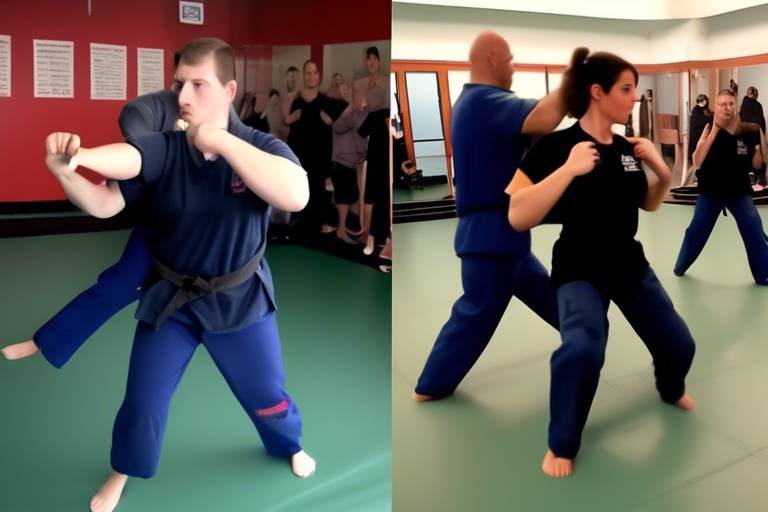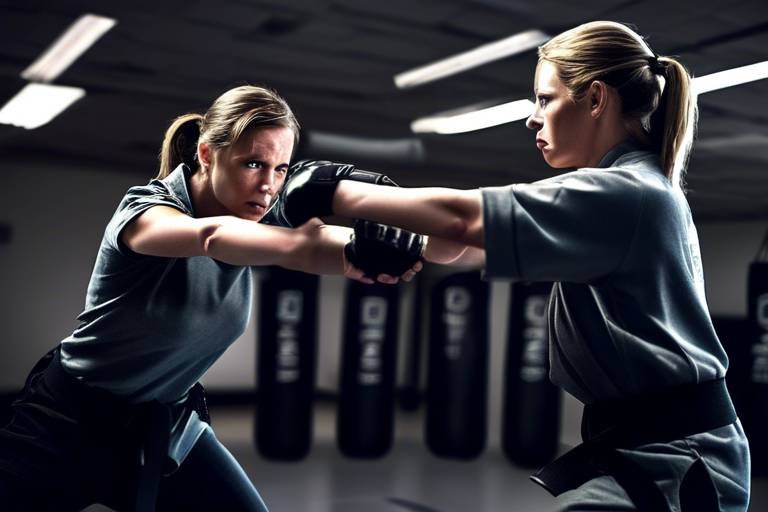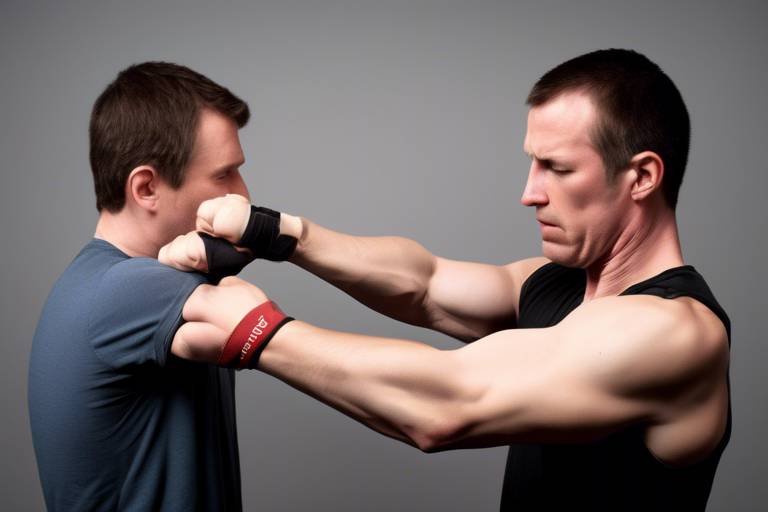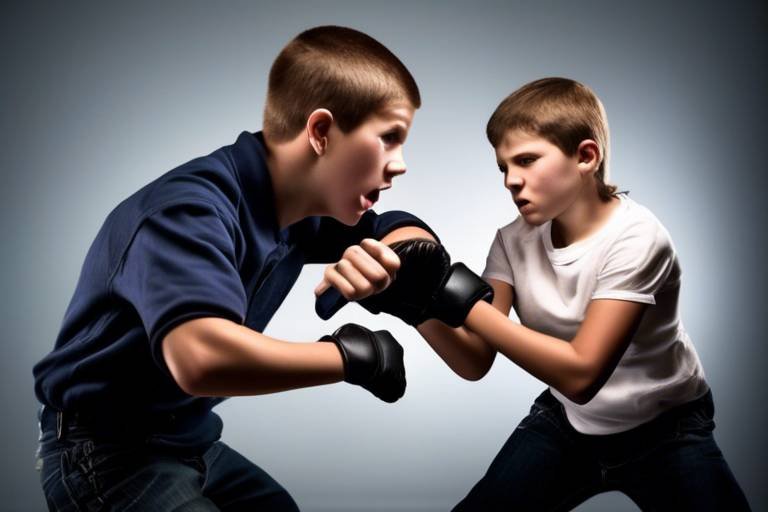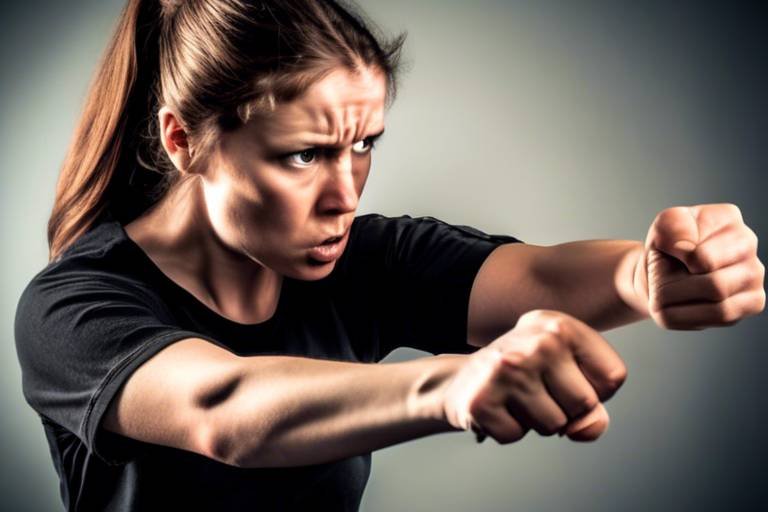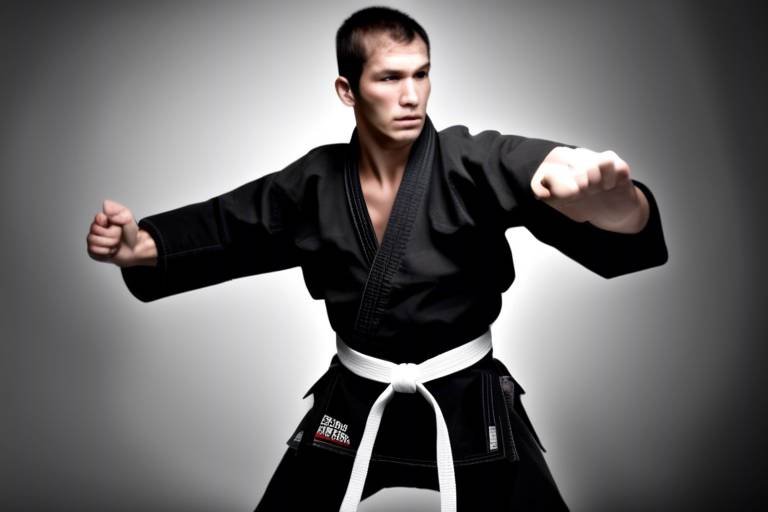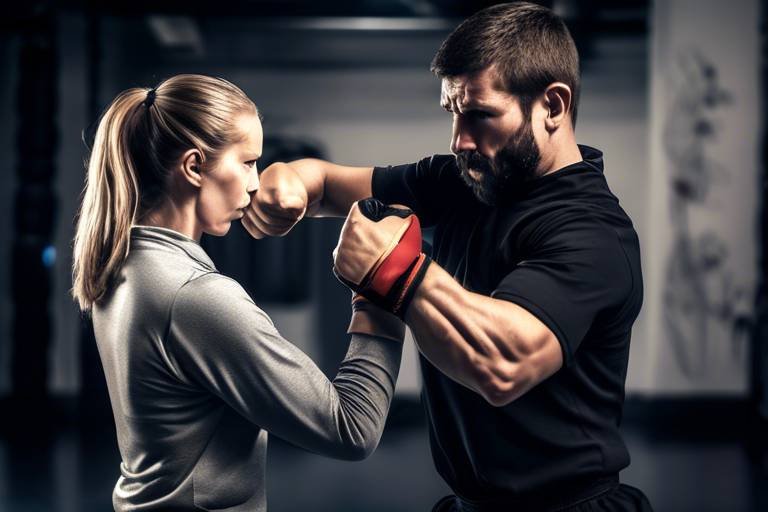The Transition from Self-Defense Training to Real-Life Application
Have you ever taken a self-defense class and thought, "What if I actually have to use this?" You're not alone! Many people wonder how the skills they learn in a controlled environment can translate to real-life situations. The truth is, self-defense training is not just about throwing punches or executing complex maneuvers; it's about building a mindset that prepares you for unexpected challenges. Imagine being in a situation where your heart races, your palms sweat, and the instinct to protect yourself kicks in. This is where the magic of self-defense training comes into play.
Self-defense training equips you with essential skills that go beyond physical techniques. It fosters a sense of awareness, confidence, and the ability to assess situations quickly. Think of it like learning to ride a bike. At first, you might wobble and fall, but with practice, you gain balance and control. Similarly, self-defense training helps you develop a mental and physical balance that can be crucial when faced with real threats.
In real life, situations can unfold in a split second, and your response needs to be instinctive. Training helps to create muscle memory, allowing you to react without overthinking. But it’s not just about physical readiness; it’s also about mental preparedness. Imagine walking down a street and suddenly sensing danger. The skills you've practiced will kick in, helping you stay calm and make the right decisions. This seamless transition from training to real-life application can be the difference between safety and harm.
Moreover, self-defense training often incorporates scenarios that mimic real-life confrontations. This realistic approach enables practitioners to visualize how they would respond in various situations, such as being approached aggressively or needing to escape a confined space. By regularly engaging in these simulations, you enhance your ability to think on your feet and adapt your techniques to fit the context of the encounter.
Ultimately, the transition from self-defense training to real-life application is about more than just physical techniques; it’s about cultivating a mindset that prioritizes safety and awareness. The skills you learn are tools that empower you to navigate the world with confidence. Whether it's a casual outing or a late-night walk, knowing you have the skills to protect yourself can be incredibly liberating.
- How long does it take to become proficient in self-defense?
Proficiency varies by individual, but consistent practice over a few months can lead to significant improvements. - Can self-defense training be beneficial for all ages?
Absolutely! Self-defense training can be adapted for various age groups, making it accessible and beneficial for everyone. - What if I encounter a situation where I can't use physical techniques?
Self-defense training also emphasizes de-escalation techniques and situational awareness, which can be just as important as physical skills.

The Importance of Self-Defense Training
Understanding the significance of self-defense training is crucial for personal safety. In today’s unpredictable world, the ability to protect oneself is not just a luxury; it’s a necessity. Self-defense training empowers individuals with the skills needed to respond effectively in potentially dangerous situations. Imagine walking down a street, and suddenly, you feel uneasy. With the right training, you can transform that anxiety into action, equipping yourself with the confidence to handle threats.
Self-defense training does more than just teach techniques; it fosters a profound sense of empowerment. When you know how to defend yourself, you walk with an air of confidence that can deter potential aggressors. It's like having a secret weapon—one that doesn't just reside in your pocket but within your mind and body. This newfound confidence can permeate every aspect of your life, from your social interactions to your professional endeavors.
Moreover, self-defense training is about more than just physical prowess. It encompasses a holistic approach to personal safety, which includes:
- Awareness: Understanding your surroundings and recognizing potential threats.
- Decision-Making: Knowing how to react quickly and effectively when faced with danger.
- Physical Techniques: Mastering moves that can help you escape or neutralize an attacker.
It's important to note that self-defense training is not solely for those who feel vulnerable. Everyone, regardless of age or gender, can benefit from learning these essential skills. Think of it as a form of personal insurance—something that may never be needed but can provide peace of mind. The investment in time and effort is minimal compared to the potential benefits of being prepared for any situation.
In essence, self-defense training is about creating a proactive mindset. It encourages individuals to take charge of their safety rather than waiting for someone else to protect them. This shift in perspective can be life-changing. It’s not just about learning to throw a punch; it’s about understanding that you have the power to control your environment. And that is a powerful realization.
As we delve deeper into the world of self-defense, we will explore key techniques and the importance of physical and mental conditioning. But before we do, let’s take a moment to reflect on the broader implications of being trained in self-defense. It’s not just about individual safety; it’s about fostering a culture of awareness and preparedness within our communities. The more people who are trained, the safer our neighborhoods can become.
| Question | Answer |
|---|---|
| Is self-defense training only for women? | No, self-defense training is beneficial for everyone, regardless of gender. |
| How long does it take to learn self-defense? | The time varies based on the individual and the training program, but even basic skills can be learned in a few classes. |
| Can self-defense training prevent attacks? | While it can't guarantee prevention, it equips individuals with skills to respond effectively if necessary. |

When it comes to self-defense, having a solid grasp of key techniques can make all the difference in a high-pressure situation. Think of self-defense as a toolbox; each technique is a tool that can be used to protect yourself when the need arises. Whether you find yourself in a tense encounter or just want to feel more secure in your daily life, mastering a few fundamental moves can empower you and enhance your confidence.
One of the most essential techniques is the escape maneuver. This technique focuses on getting out of a hold or a dangerous situation as quickly as possible. For instance, if someone grabs your wrist, a simple yet effective escape can involve rotating your wrist towards your thumb and pulling away. This technique not only frees you but also allows you to create distance from the aggressor, giving you a chance to assess your next move.
Another vital technique is the defensive stance. When faced with a potential threat, adopting a defensive posture can signal your readiness to protect yourself. This stance involves keeping your feet shoulder-width apart, slightly bending your knees, and positioning your hands in front of your face to guard against strikes. This not only prepares you for an attack but also projects an air of confidence, which can sometimes deter an aggressor.
Moreover, striking techniques, such as the palm strike or the knee strike, are crucial for self-defense. A palm strike can be delivered to an attacker's face or chest, utilizing the heel of your palm to deliver a powerful blow. This technique is effective because it minimizes the risk of injuring your own hands, which can happen with a traditional fist punch. Similarly, a knee strike can be used to target an attacker's groin, providing you with a moment of advantage to escape or further defend yourself.
Now, let's not forget about the importance of awareness. Self-defense is not just about physical techniques; it’s also about being aware of your surroundings. Developing a keen sense of awareness can help you identify potential threats before they escalate. This includes recognizing suspicious behavior, understanding your environment, and knowing escape routes. In fact, many self-defense experts argue that the best defense is often avoiding confrontation altogether.
To illustrate these techniques further, consider the following table that summarizes some key self-defense moves and their applications:
| Technique | Description | Application |
|---|---|---|
| Escape Maneuver | Freeing yourself from a hold | When grabbed by the wrist |
| Defensive Stance | Positioning yourself to defend | To guard against strikes |
| Palm Strike | Using the palm to hit | To create distance from the attacker |
| Knee Strike | Striking with the knee | Targeting the groin for a quick escape |
In conclusion, mastering these key techniques in self-defense not only equips you with the skills to protect yourself but also fosters a sense of empowerment and confidence. Remember, self-defense is about being prepared and knowing how to respond effectively in various situations. So, whether you're training in a dojo or practicing at home, keep these techniques in mind, and you'll be well on your way to enhancing your personal safety.
- What is the best self-defense technique for beginners? Many experts recommend starting with escape maneuvers and defensive stances, as these can be applied in a variety of situations.
- How can I improve my awareness in public places? Practice scanning your environment regularly, noting exits, and observing the behavior of those around you.
- Is physical fitness necessary for self-defense? While not mandatory, being physically fit can enhance your ability to execute techniques effectively and escape dangerous situations.

When it comes to self-defense, physical conditioning is not just an add-on; it’s a fundamental pillar that can make or break your ability to protect yourself in a real-life situation. Think of it this way: if your body is a car, physical conditioning is the engine. Without a powerful engine, even the best-designed car won't get very far. Similarly, if you're not physically prepared, even the most effective self-defense techniques can fall flat in high-stress scenarios.
Being fit enhances your strength, agility, and endurance, all of which are crucial when facing an unexpected confrontation. Imagine having to escape a dangerous situation—if you're out of breath or your muscles are fatigued, your response time will slow down significantly, and you might not be able to execute your self-defense techniques effectively. Therefore, incorporating a well-rounded fitness routine into your self-defense training is essential.
So, what does a solid physical conditioning program look like for self-defense? It should ideally focus on the following areas:
- Strength Training: Building overall body strength is crucial. Exercises like push-ups, squats, and weightlifting can enhance your ability to execute powerful moves when necessary.
- Cardiovascular Fitness: Improving your heart and lung capacity through running, cycling, or high-intensity interval training (HIIT) will help you maintain stamina during a confrontation.
- Flexibility and Agility: Incorporating stretching and agility drills can enhance your ability to move quickly and fluidly, which is essential for dodging attacks or escaping dangerous situations.
Additionally, it's important to remember that physical conditioning is not just about working out in the gym. Real-life scenarios can be unpredictable, and your body needs to be prepared for various movements. This is where functional training comes into play. Functional exercises mimic real-world activities, helping to improve your body’s ability to respond to sudden physical demands. Think of climbing over obstacles or quickly changing direction—your training should prepare you for these situations.
Moreover, incorporating self-defense drills into your physical conditioning routine can enhance muscle memory. Repeated practice of techniques in a physically demanding environment helps to create a connection between your mind and body, allowing you to react instinctively when it matters most. This is where the magic happens; you’re not just learning moves; you’re conditioning your body to respond automatically under pressure.
In conclusion, physical conditioning for self-defense is a holistic approach that encompasses strength, endurance, flexibility, and functional movement. By prioritizing your fitness, you not only enhance your self-defense skills but also build confidence in your ability to handle any situation that comes your way. Remember, the stronger and more prepared you are, the more capable you’ll feel when facing the unexpected.
1. How often should I train for self-defense?
It’s recommended to train at least 2-3 times a week, incorporating both physical conditioning and self-defense techniques to build a well-rounded skill set.
2. Can I do self-defense training at home?
Absolutely! There are many online resources and videos that can guide you through self-defense techniques and conditioning exercises that you can do in the comfort of your own home.
3. Is physical conditioning the only aspect of self-defense?
While physical conditioning is critical, mental preparedness, awareness, and understanding legal implications are also essential components of effective self-defense.

Mental preparedness is not just a secondary aspect of self-defense; it is the backbone that supports all physical training. Imagine stepping into a ring where the opponent is not just a person, but fear, doubt, and anxiety. In self-defense, the mind plays a pivotal role in determining the outcome of a confrontation. The ability to remain calm and composed under pressure can mean the difference between walking away unscathed or succumbing to panic. So, how do we cultivate this mental strength?
Firstly, awareness is key. Being aware of your surroundings can significantly enhance your ability to respond to potential threats. This means not just looking but truly observing. Are there people around you? What are their behaviors? Are there exits nearby? This heightened sense of awareness can prepare you mentally for any unexpected situations. It’s like being a detective in your own life, always on the lookout for clues that could indicate danger.
Moreover, decision-making under pressure is another critical component of mental preparedness. When faced with a confrontation, your brain must process information quickly. This is where mental rehearsals come in. By visualizing potential scenarios, you can train your brain to react instinctively. Picture this: you're walking down the street, and suddenly someone approaches you aggressively. Instead of freezing, your mind recalls the techniques you've practiced. This is the power of mental conditioning.
To further enhance your mental preparedness, consider the following techniques:
- Breathing Exercises: Deep breathing can help calm your nerves and clear your mind. Practice breathing techniques to help you stay composed in high-stress situations.
- Positive Visualization: Regularly visualize yourself successfully handling confrontations. This creates a mental blueprint that your brain can follow in real situations.
- Mindfulness Meditation: Engaging in mindfulness can improve your focus and ability to remain present, which is essential when assessing threats.
Lastly, remember that mental preparedness is an ongoing process. Just like physical training, it requires consistent practice and dedication. By integrating mental exercises into your routine, you can build a resilient mindset that not only prepares you for confrontation but also enhances your overall confidence in your daily life. The next time you step out, you won’t just be prepared physically but mentally ready to face whatever comes your way.
1. What is the most important aspect of mental preparedness for self-defense?
The most important aspect is awareness. Being conscious of your surroundings can help you anticipate and avoid potential threats.
2. How can visualization techniques help in real-life situations?
Visualization techniques can help train your brain to respond instinctively to confrontations, making your reactions more effective and confident.
3. Are there specific exercises to improve mental preparedness?
Yes, exercises such as breathing techniques, mindfulness meditation, and positive visualization can significantly enhance mental preparedness.
4. How often should I practice mental preparedness techniques?
Regular practice is key; incorporating these techniques into your daily routine can yield the best results over time.

When it comes to self-defense, one of the most powerful tools at your disposal is the art of visualization. Imagine standing in a crowded street, and suddenly, you find yourself facing a potential threat. How would you react? Would you freeze, or would your training kick in? Visualization is not just daydreaming; it's a technique that can significantly enhance your preparedness for real-life confrontations.
By mentally rehearsing various scenarios, you can create a mental library of responses that you can draw upon when the unexpected occurs. Think of it as a mental dress rehearsal for a play. Just as actors prepare for their roles by envisioning their lines and actions, you can prepare for potential confrontations by envisioning your responses. This mental preparation can lead to quicker reaction times and a more composed demeanor when faced with actual danger.
To effectively utilize visualization, consider the following steps:
- Identify Scenarios: Think about different situations where self-defense might be necessary. This could range from a street altercation to a more subtle form of aggression, like someone invading your personal space.
- Engage Your Senses: When visualizing, engage all your senses. What do you see, hear, and feel? This immersive approach makes the experience more realistic and prepares your brain for actual events.
- Practice Regularly: Just like any skill, the more you practice visualization, the more effective it becomes. Dedicate a few minutes each day to mentally rehearse various scenarios.
Moreover, it's crucial to visualize not just the physical actions you'll take, but also the emotional responses. How will you feel? Will you be scared, or will you harness that fear into a focused energy? Understanding and preparing for your emotional state can be just as vital as knowing the right techniques.
Incorporating visualization into your self-defense training can lead to a greater sense of confidence. When you can picture yourself successfully defending against an attacker, your mind becomes accustomed to the idea of taking action rather than succumbing to fear. This mental conditioning can be the difference between feeling paralyzed in a moment of crisis and responding effectively.
Ultimately, visualization is about creating a mental framework that allows you to navigate real-life situations with clarity and purpose. By envisioning potential threats and your responses to them, you can transform fear into empowerment, making you not just a participant in your own safety, but a proactive defender of it.
1. How often should I practice visualization for self-defense?
It's recommended to practice visualization daily, even if it's just for a few minutes. Consistency helps reinforce your mental preparedness.
2. Can visualization replace actual physical training?
While visualization is a powerful tool, it should complement, not replace, physical training. Both mental and physical preparedness are essential for effective self-defense.
3. What if I struggle to visualize scenarios?
If you find visualization challenging, start with simpler scenarios and gradually build up to more complex ones. You can also use guided imagery techniques or apps designed for mental rehearsal.
4. Does visualization really work?
Many athletes and professionals use visualization techniques to enhance their performance, and studies show that it can improve reaction times and confidence in high-pressure situations.

When it comes to self-defense, one of the biggest challenges is translating what you learn in a controlled training environment to the unpredictable chaos of a real-life confrontation. It’s like learning to swim in a swimming pool and then being thrown into the ocean; the principles remain the same, but the environment is vastly different. To truly equip ourselves for unexpected situations, we need to adapt our training to reflect the realities we might face.
First and foremost, it's essential to incorporate realistic scenarios into your training regimen. This means practicing techniques in environments that simulate real-world conditions. For instance, practicing in dim lighting or in crowded spaces can help you develop the ability to react under pressure. Consider the following adaptations:
- Scenario-Based Drills: Create drills that mimic potential threats you might encounter, such as an attacker approaching from behind or someone trying to grab you in a public place.
- Role-Playing: Work with a partner to act out various situations. This not only helps with technique but also builds confidence in your ability to respond appropriately.
- Stress Inoculation: Introduce elements of stress during training, like loud noises or time constraints, to simulate the pressure of a real confrontation.
Moreover, adapting your training means being aware of your surroundings and the context in which you might need to defend yourself. This involves developing a keen sense of situational awareness. It’s not just about knowing how to throw a punch or escape a hold; it’s about understanding when and where these skills might be necessary. In many cases, avoiding a confrontation altogether is the best form of self-defense. This could mean:
- Recognizing potential threats before they escalate.
- Choosing safer routes when walking alone at night.
- Trusting your instincts and leaving a situation if something feels off.
Additionally, it's crucial to keep in mind that self-defense isn't solely about physical techniques. It's also about mental agility. Practicing decision-making under pressure can make a significant difference. For example, during training, you might want to simulate a situation where you have to decide whether to engage or escape. This kind of mental rehearsal prepares you for the split-second decisions you’ll need to make in a real-life scenario.
Finally, remember that self-defense is a continuous journey. As you grow and evolve, so should your training. Regularly revisiting and updating your skills ensures that you remain prepared for whatever life throws your way. Embrace the unpredictability, and view each training session as an opportunity to refine your ability to adapt. After all, the most effective self-defense practitioners are those who can think on their feet and adjust their responses based on the situation at hand.
Q: How often should I practice self-defense techniques?
A: It's recommended to practice regularly, ideally at least once a week, to keep your skills sharp and your confidence high.
Q: Can self-defense training help with confidence?
A: Absolutely! Learning self-defense techniques empowers individuals and boosts their confidence, making them feel more secure in potentially dangerous situations.
Q: What should I do if I find myself in a real-life confrontation?
A: Trust your instincts, assess the situation quickly, and remember your training. If possible, prioritize de-escalation and escape over physical confrontation.
Q: Are there legal implications I need to be aware of?
A: Yes, understanding the laws surrounding self-defense in your area is crucial. Always be aware of your rights and the legal protections available to you.

Understanding the legal implications of self-defense is crucial for anyone who has undergone training in this area. Knowing when and how you can legally protect yourself can make a significant difference in the outcome of a confrontation. Self-defense laws vary widely from one jurisdiction to another, and being unaware of these laws can lead to serious consequences, including criminal charges or civil lawsuits. For instance, in some places, the use of force is justified only when there is an imminent threat to your safety, while in others, the laws may be more lenient.
It's essential to grasp the concept of proportionality in self-defense situations. This means that the level of force used in self-defense should correspond to the threat faced. For example, if someone pushes you, responding with lethal force could be deemed excessive. Understanding these nuances can help you navigate the legal landscape effectively.
Moreover, being aware of your rights in self-defense situations is vital. Here are some key points to consider:
- Right to Protect Yourself: Most jurisdictions grant individuals the right to defend themselves from imminent harm.
- Duty to Retreat: Some places require individuals to retreat if it is safe to do so before using force.
- Stand Your Ground Laws: In certain areas, individuals have no duty to retreat and can use force without backing down.
These points illustrate how crucial it is to familiarize yourself with the laws applicable in your area. When you know your rights, you can act with greater confidence and clarity during a confrontation, knowing that you are within your legal boundaries.
Furthermore, the aftermath of a self-defense incident often involves legal scrutiny. It is wise to be prepared for the possibility of law enforcement involvement. This means being ready to explain your actions clearly and calmly. Keeping a level head during such stressful situations can greatly influence how your case is perceived by authorities and the legal system.
In many cases, individuals who successfully defend themselves in a legal context may still face civil lawsuits from the aggressor or their family. This is where having a solid understanding of self-defense laws becomes even more critical. It’s advisable to consult with a legal professional who specializes in self-defense cases to ensure you are fully informed of your rights and responsibilities.
In summary, while self-defense training equips you with the skills to protect yourself, understanding the legal framework surrounding these actions is equally important. By being informed about your rights and the laws in your jurisdiction, you can ensure that you are prepared not just physically, but also legally, for any potential confrontations.
Here are some common questions regarding legal considerations in self-defense:
- What should I do immediately after a self-defense incident? It's crucial to contact law enforcement and seek legal advice as soon as possible.
- Can I be sued for using self-defense? Yes, even if you acted legally, the aggressor may choose to pursue a civil suit.
- Do I need to report a self-defense incident? In most cases, yes. Reporting to the police can help document your side of the story.

Understanding your rights in self-defense situations is not just a matter of legal knowledge; it's about empowering yourself to act decisively and confidently when faced with potential threats. Many people underestimate the importance of knowing these rights, thinking that self-defense is simply about physical prowess. However, the law provides a framework that protects individuals who act in self-defense, ensuring that they can respond to threats without the fear of legal repercussions. This knowledge can be the difference between feeling vulnerable and feeling empowered.
When we talk about self-defense rights, we are essentially discussing the legal protections afforded to individuals who find themselves in threatening situations. It's vital to grasp the concept of "reasonable force," which refers to the level of force that is appropriate to prevent harm to oneself or others. Here are some key points to consider:
- Reasonable Force: The law typically allows individuals to use reasonable force to defend themselves. This means that the level of force used should be proportional to the threat faced.
- Duty to Retreat: In some jurisdictions, there is a legal obligation to retreat from a threatening situation if it is safe to do so. However, in others, the "Stand Your Ground" law permits individuals to defend themselves without retreating.
- Imminent Threat: Self-defense can only be claimed if there is an imminent threat of harm. This means that the danger must be immediate and unavoidable.
It's essential to familiarize yourself with the specific laws in your area, as they can vary significantly from one jurisdiction to another. For example, some states have "Castle Doctrine" laws, which allow individuals to use force to protect themselves in their own homes without the duty to retreat. Understanding these nuances can provide you with the confidence to act appropriately in high-stress situations.
Moreover, knowing your rights doesn’t just prepare you for physical confrontations; it also equips you to handle the aftermath of such encounters. For instance, if you are involved in a self-defense incident, being aware of your rights can help you navigate interactions with law enforcement. You have the right to remain silent and to seek legal counsel. Remember, the way you communicate your actions and intentions can significantly impact the legal outcomes.
In summary, being educated about your rights in self-defense scenarios is an indispensable part of your training. It enhances your ability to act with confidence and clarity, ensuring that you not only protect yourself physically but also legally. Knowledge is power, and when it comes to self-defense, understanding the law can be as crucial as mastering the techniques themselves.
Here are some common questions regarding self-defense rights:
- What is considered "reasonable force" in self-defense? Reasonable force is the minimum amount of force necessary to protect yourself from harm, which must be proportional to the threat faced.
- Do I have to retreat before using self-defense? It depends on the laws in your state. Some places require you to retreat if it is safe to do so, while others allow you to stand your ground.
- What should I do immediately after a self-defense incident? It’s crucial to contact law enforcement and seek legal advice. Document the incident as thoroughly as possible, including witnesses and evidence.

When it comes to self-defense, the mantra is clear: knowledge is power. Educating others about self-defense not only helps individuals feel more secure in their everyday lives but also fosters a culture of safety and awareness within communities. Imagine a neighborhood where everyone is equipped with the basic skills to protect themselves; it’s like creating a safety net that can catch anyone who might fall into danger. This is why sharing knowledge about self-defense is so crucial.
One of the most effective ways to educate others is through organized workshops and training sessions. These can be tailored to different age groups and skill levels, ensuring that everyone from children to seniors can benefit. For instance, a workshop for kids might focus on awareness and avoidance strategies, while an adult class could delve into more physical techniques. By providing a variety of training options, you cater to the unique needs of your community, making self-defense accessible to all.
Furthermore, incorporating real-life scenarios into training can significantly enhance learning outcomes. When participants practice techniques in a controlled environment that mimics real-life situations, they not only learn the moves but also develop the mental preparedness required for actual confrontations. This kind of practical education can be the difference between panic and calm during a stressful encounter.
Additionally, community outreach programs can play a pivotal role in spreading self-defense awareness. These programs can include:
- Free self-defense classes in local community centers
- Partnerships with schools to integrate self-defense into physical education
- Online resources and webinars that provide valuable information and techniques
By engaging with local organizations, businesses, and schools, you can amplify your reach and make self-defense training a community-wide initiative. This not only empowers individuals but also builds a network of support where everyone looks out for one another.
In conclusion, educating others about self-defense is not just about teaching physical techniques; it’s about instilling confidence and awareness. When individuals feel empowered, they are more likely to take proactive steps in their personal safety. So, consider hosting a workshop, sharing resources, or simply talking to friends and family about the importance of self-defense. Together, we can create a safer environment for everyone.
Q1: What age is appropriate to start self-defense training?
A1: Self-defense training can begin as early as childhood, with age-appropriate techniques focusing on awareness and avoidance. Many programs cater specifically to children, teaching them how to recognize and avoid dangerous situations.
Q2: Do I need to be physically fit to learn self-defense?
A2: While physical fitness can enhance your self-defense capabilities, many techniques can be learned and applied by individuals of all fitness levels. The key is to focus on technique and strategy rather than brute strength.
Q3: How can I find a self-defense class in my area?
A3: You can search online for local martial arts studios, community centers, or gyms that offer self-defense classes. Additionally, social media and community bulletin boards can provide information about upcoming workshops and events.
Q4: Is self-defense training effective in real-life situations?
A4: Yes, self-defense training is designed to prepare individuals for real-life encounters. By practicing techniques and scenarios, participants develop the skills and confidence needed to respond effectively in dangerous situations.
Frequently Asked Questions
- What is the main benefit of self-defense training?
Self-defense training empowers individuals with the skills and confidence to protect themselves in potentially dangerous situations. It not only enhances personal safety but also builds mental resilience, allowing practitioners to respond effectively under pressure.
- Can self-defense techniques be adapted for real-life situations?
Absolutely! Adapting self-defense techniques to real-life scenarios is crucial. Practitioners should modify their training to reflect unpredictable situations, ensuring they can apply their skills effectively when it matters most.
- How important is physical conditioning in self-defense?
Physical conditioning is vital for executing self-defense techniques successfully. Being fit and agile helps you react swiftly and effectively during high-stress confrontations, making it easier to defend yourself when the need arises.
- What role does mental preparedness play in self-defense?
Mental preparedness is just as important as physical training. It involves being aware of your surroundings, making quick decisions, and staying calm under pressure, all of which can significantly influence the outcome of a confrontation.
- Are there legal considerations I should be aware of in self-defense?
Yes, understanding the legal implications of self-defense is crucial. Knowing your rights and the laws surrounding self-defense actions can help you act confidently and responsibly during a confrontation, ensuring you remain within legal boundaries.
- How can I educate others about self-defense?
Sharing knowledge about self-defense can empower your community. Organizing training programs or workshops can foster a safer environment by equipping others with the skills and confidence they need to protect themselves.

